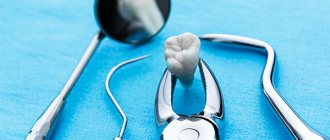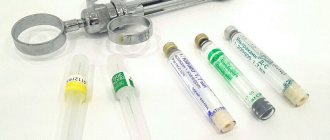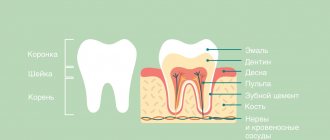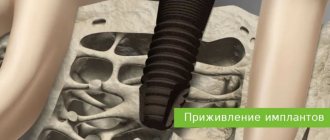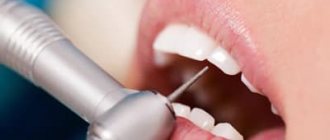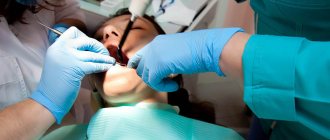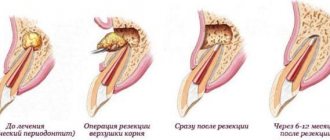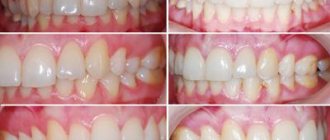In the last century, when asked whether it is painful to remove the root of a tooth if the crown is completely destroyed, many dentists would have given an affirmative answer. Pain during and after the procedure, complications from anesthesia and discomfort plagued many patients. But today the situation has changed - a sick tooth and its root can be pulled out absolutely painlessly
.
Who will have to part with a tooth?
Complications following tooth extraction in the doctor's office are extremely rare. Much more often, sad consequences occur when it spontaneously falls out due to destruction or injury. In such cases, there are two options: restoration of dentin and enamel or removal of the tooth root.
The tooth root will have to be removed if the following symptoms occur:
- constant discomfort in the gums;
- sharp pain when chewing;
- swollen soft tissue;
- bleeding;
- the appearance of pus.
A sure sign of an inflammatory process in the gums is an increase in body temperature in the absence of symptoms of another disease.
Important! You cannot postpone a visit to the dentist, even if only one of these symptoms appears. Any suspicion that the tooth root remains in the gum and has begun to rot should prompt an urgent visit to a doctor.
What are the roots of teeth, look at the photo:
Temporary contraindications
Surgical removal of the root of a decayed tooth is contraindicated during:
- relapse of complex mental disorder;
- acute phase of ARVI;
- exacerbation of neurological disease;
- rehabilitation after a heart attack.
Doctors at dental clinics are aware of all contraindications to extraction. But not all conditions have clear clinical signs, so in order to avoid unpleasant consequences, it is necessary to warn the doctor about the ailment.
Prosthetics of 6 teeth
What crowns to put
Crown for a chewing tooth
Installing a crown on the sixth tooth
How to care for a crown
Implantation of 6 teeth
Many people believe that the first permanent teeth are the lower incisors. Actually this is not true. The first to appear are the molars—the sixth teeth, or “sixes.” They erupt behind the second primary molars and line up with the rest of the baby teeth. Due to the fact that the sixth teeth are “pioneers” among other molars, they bear a large chewing load. With poor hygiene or untimely treatment, these teeth begin to decay. Today there are many methods for restoring “sixes”; let’s dwell in more detail on prosthetics.
Generalized scheme for tooth extraction
The process of removing any tooth includes the following steps:
- Examination and collection of anamnesis (allergic status, information about the state of health and the dental apparatus).
- Preparation of the surgical field: treatment of the injection site, rinsing the mouth with an antiseptic.
- Anesthesia.
- Detachment of gum from tooth using a trowel.
- Loosening a tooth with forceps.
- Extracting a tooth from its socket.
- Treating the hole with an antiseptic.
- Stop bleeding with tamponade.
According to this scheme, simple removal is carried out. In some situations, for example, when a wisdom tooth or a badly damaged molar is pulled out, a complex extraction is required. Its main difference is that in addition to forceps, the dentist uses a drill to cut out bone tissue or saw the root into pieces, a chisel, a hammer and other dental instruments.
Wisdom tooth removal diagram
Getting rid of a wisdom tooth can be especially difficult. Due to its location in the posterior quadrant of the jaw, access to it is difficult. With anatomically incorrect or curved roots, which are often found in third molars, the dentist may be forced to make incisions in the gums, pull out the root piece by piece, and then apply sutures.
Gastrointestinal disorders
A person chews food mainly with chewing teeth, which patients are often in no hurry to restore. As a result, food before entering the stomach is crushed less well and is not so abundantly moistened with saliva, which contains enzymes that trigger the process of breaking down nutrients in the oral cavity.
Due to poor chewing, not only gastritis with constant dull pain in the epigastrium can appear, but also cholelithiasis, stool disorders, colitis and other unpleasant diseases.
How is a decayed tooth removed?
The process of tooth extraction is a simple dental operation. The difficulty increases when you need to remove the root of a tooth that is completely destroyed. Factors requiring the intervention of an experienced specialist:
- small size of the remaining crown;
- condition of surrounding tissues;
- the location of the remaining hard tooth tissues under the upper edge of the gums;
- defects of gums, roots.
Affects the complexity of the operation and whether the position of the upper or lower jaw belongs. In the upper jaw, the walls of the sockets are longer and thicker; accordingly, teeth are removed from them with great difficulty - a highly qualified dentist is required to perform the manipulation.
Wisdom teeth, from which only the root remains, are removed in the same way as ordinary molars, but in some patients, healing after such an intervention is very painful.
Examination and preparation
The procedure begins with a thorough examination and preparation of the patient. When you first visit the clinic, the doctor will take an x-ray and examine the oral cavity.
Doctor's tasks:
- determine the condition of the tooth, assess the extent of destruction;
- clarify the presence of allergies, contraindications, inflammation;
- choose a method of pain relief;
- draw up an operation plan;
- prepare tools.
The tools used to remove a rotten tooth root are a drill, forceps, and a set of elevators (photo).
A prerequisite is hygienic treatment of adjacent tissues. Extraction is possible only after removing stones and plaque from the molars, incisors or canines surrounding the surgical field. Immediately before extraction, the oral cavity is treated with a Chlorhexidine solution.
Anesthesia
There are cases when dentin is destroyed gradually, without inflammation, without the appearance of rot. In such situations, painless root removal is possible without the use of painkillers, however, anesthesia is more often necessary.
The choice of drug is carried out taking into account:
- age;
- allergic status;
- presence of somatic diseases;
- individual intolerance to drugs;
- presence of chronic diseases: epilepsy, diabetes;
- complexity of the upcoming operation.
The patient must notify the dentist about any deviations before the procedure begins. In most cases, the tooth root is removed under local anesthesia - one or two injections for incisors, 2 to 4 injections into the gums for molars. But if two teeth are destroyed, or the jaw is to be opened, the patient receives general anesthesia - he will sleep until the doctor finishes pulling out the tooth.
Features of pain relief for a tooth with a rotten root
An anesthetic injection is given at the site of the projection of the tooth roots. But if the medicine is injected into the rotten area, it may not work and the person will be hurt during the extraction process.
Treatment of patients with rotten roots is carried out in two stages. On the first visit, the dentist numbs the gum, prepares it and cleans it of pus. During the second visit, anesthesia is repeated, and the doctor removes the root that has rotted inside the gum.
Removal
The doctor decides how to remove a tooth if only the root remains. Usually they start with the use of forceps. Even if the destroyed roots remain under the gum, the holes do not completely heal - the dentist can carefully pick up the remnants of hard tissue and easily pull them out.
If the tooth has crumbled to the very base, it is pulled out with an elevator. Having inserted the instrument between the gum and dentin, the doctor presses on the handle and makes rotational movements of small amplitude. As a result, the periodontal fibers shift and the root is squeezed out of the socket.
A drill is used when it is necessary to crush the hard tissues of a molar before removal. With proper anesthesia, this procedure is painless; discomfort is possible only when the gums are already healing.
Relieving inflammation
When removing a rotten root, an inflammatory process is often detected. To ensure that the wound heals safely and does not fester, it is customary to treat it with an antiseptic. But one treatment will not provide adequate prevention, so an anti-inflammatory drug is placed in a fresh hole. With it, the hole will heal faster, and the patient will have less chance of developing alveolitis.
Stitching
To extract the root system, the doctor separates and lifts flaps of soft tissue; they can only be attached back by suturing. It is customary to tighten the edges of the holes with threads during double or triple removal, when a significant part of the gum has been subjected to preparation. This is done so that the affected area heals faster and does not cause discomfort to the patient.
Installing a crown on the sixth tooth
The method of installing a crown depends on the degree of destruction of the crown part of the tooth. If, as a result of treatment, it is possible to save the tooth, but the filling area is large, then dentists recommend installing a crown. If the degree of destruction is small, but there are indications for installing a crown (chips, changes in enamel, abrasion of the tooth), then the tooth is given the desired shape, and then the crown is fixed.
If there is practically nothing left of the crown part of the tooth, then first a pin is installed in the treated root canal, then the tooth is built up on it, prepared, and only then a crown is installed.
Prosthetics consists of several stages
- Consultation and examination, referral for imaging, approval of a treatment plan.
- Sanitation of the oral cavity: professional hygiene, treatment of dental diseases and inflammatory processes.
- Preparing the tooth for crown installation: root canal treatment, pulp removal (if necessary), restoration of the coronal part with a filling, giving the tooth a cylindrical shape.
- Taking an impression, making a plaster model, from which the crown will then be cast. Our clinic has its own dental laboratory, which allows us to produce orthopedic structures on the same day. If it takes more than a day to create a crown, for example, when the clinic does not have its own dental laboratory, then a temporary onlay is placed on the tooth to protect it from germs and various damages.
- Trying on the structure and fixing it with dental cement.
If there are root fragments left in the hole
If the wound edges were tightened with catgut, the patient’s treatment can be considered complete. If a non-absorbable material was used, the patient will have to return to the dentist to have the sutures removed after a week. During this time, it is necessary to monitor the condition of the gums, your own sensations and notify the doctor if:
- the operated areas constantly hurt;
- throbbing pain is felt.
This means that small fragments of tooth tissue, which may have gone unnoticed during extraction, rot in the hole. The doctor must prescribe a repeat X-ray for the patient, check the quality of the operation and find out the cause of the ailment. Inaction is fraught with the development of alveolitis (inflammation of the socket), osteomyelitis, phlegmon and other serious diseases.
Possible consequences and complications
Extraction, like any operation, can cause a negative reaction from the body. If your cheek is swollen, your throat hurts, or there is a sharp throbbing pain in the socket, there is a high probability of an inflammatory process.
Early complications:
- fainting, shock, collapse;
- fracture, dislocation of the jaw;
- perforation of the maxillary sinus (when removing an upper molar or premolar), falling of root fragments into the gum;
- trauma, dislocation, fracture of an adjacent or opposite tooth;
- severe bleeding, hematoma formation.
Late complications:
- inflammation of the alveoli (alveolitis);
- inflammation of peripheral nerves (neuritis);
- restriction of jaw movement (muscle contracture).
By contacting a specialist in a timely manner, the consequences of removal can be minimized.
How to remove a rotten tooth root while preserving the crown
A tooth in which only the root remains is not always pulled out entirely. For example, if an inflammatory process develops at the root apex, but the tooth itself can still be saved, resection of the root apex is performed - partial removal.
The procedure is carried out after filling the canals, under local anesthesia. The operation is simple and lasts no more than half an hour. Its main stages:
- Anamnesis collection.
- Preparation of the surgical field.
- Anesthesia.
- Cutting the gum to access the root.
- Delamination of soft tissues.
- Sawing out a “window” in the bone.
- Cutting off the inflamed area of the root with a granuloma or cyst.
- Placing drugs into the cavity that stimulate bone growth.
- Stitching.
Implantation of 6 teeth
The implant on the sixth tooth is installed more often than others, since it is a “running” tooth, that is, it actively participates in chewing, and therefore deteriorates faster than others. As a rule, the restoration of the sixth tooth is performed using the classical (two-stage) method: first, an implant is installed, and after 4-6 months, when the implant has completely taken root, a crown is installed.
A long-term absence of sixes can lead to displacement of neighboring units and, accordingly, to a change in the bite. The teeth located on the opposite jaw will move forward, which threatens to expose the roots. Therefore, to maintain healthy teeth and bite, it is recommended to install an implant.
What to do after deletion
After any surgical intervention, you should follow all the dentist’s recommendations, as well as:
- do not eat for 2 hours after the procedure;
- cool the soft tissues of the face in the projection of the removed root;
- stop smoking for two days;
- take prescribed pain medication;
- make antiseptic applications;
- watch to see if other teeth are crumbling.
Sometimes after complex extractions, dentists prescribe antibiotics to patients.
This appointment cannot be ignored - after a tooth is pulled out of the socket, a focus of infection forms in it, which can only be extinguished with the help of medications.
The following video schematically shows different methods for removing incisors, canines, molars and premolars of the lower and upper jaw.
External changes
Due to missing teeth, facial muscles weaken, facial tissues begin to sag, which visually increases a person’s age and adds 7-10 years to it. The chin becomes sharper, the lower jaw protrudes above the upper jaw, the corners of the lips and the tip of the nose droop. This changes the overall facial expression, which constantly appears gloomy and dissatisfied to others. From a close distance, the absence of a tooth is clearly visible, even if it is not part of the smile.
Is it possible to remove it at home?
Removing a tooth on your own is dangerous; at home, it is difficult to ensure sterility, numb the gums, ensure that the root is completely pulled out, and prevent blood loss and other complications. You can remove only a very loose tooth yourself without risk to your health.
Typically, children's loose baby teeth are removed at home. It is important to remove food debris and thoroughly disinfect the oral cavity. You need to tightly grasp the tooth with your fingers wrapped in sterile gauze, loosen it well and only then pull it. If after the second attempt you are unable to pull out the tooth, entrust this difficult manipulation to an experienced dentist without risking your health.
If the tooth comes out of the socket easily, you need to press the gauze swab firmly onto the wound to stop the bleeding and hold it for 30-40 minutes. You should refrain from eating for two hours.
If any unpleasant discomfort occurs, it is advisable to consult a dentist as soon as possible to prevent complications from developing.
Finally, I would like to remind you: simple preventive measures will allow you to keep your smile snow-white and your teeth healthy and strong for many years.
Methods
There are two ways to pull out a lower tooth:
- Simple. It is relevant if the coronal part has been preserved in sufficient volume (the dentist has something to grasp with forceps).
- Surgical. It is used if access to the tooth is difficult or its upper part is severely damaged, as well as when molars, canines and incisors have not fully erupted. In such cases, in order to minimize the risk of developing severe postoperative inflammation, professional hygiene is first carried out and plaque accumulations are removed, and the patient is prescribed antibiotics a few days before the procedure.
Before extirpation, local anesthesia is administered. It makes the working area insensitive to manipulation and helps the patient easily endure all procedures.
When should a lower tooth not be removed?
If we talk about contraindications to surgical intervention, then it will have to be postponed if:
- Cardiovascular pathologies. It is necessary that at least three to six months have passed after a hypertensive crisis, heart attack, coronary disease and other severe cardiac pathologies.
- Acute diseases of the kidneys, liver, pancreas.
- ARVI and ARI. This refers to flu, colds, pneumonia, etc.
- Disturbances in the functioning of the cardiovascular system, for example, with meningitis, encephalitis, problems with cerebral circulation.
- Exacerbations of mental illness.
- Untreated diseases of the oral cavity - stomatitis, gingivitis, gumboil, etc.
As soon as the underlying disease is cured, extirpation can be performed immediately, but not before. Otherwise, the recovery process will be delayed and complicated.
